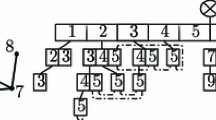Abstract
In this article we introduce a method of constructing binary linear codes and computing their weights by means of Boolean functions arising from mathematical objects called simplicial complexes. Inspired by Adamaszek (Am Math Mon 122:367–370, 2015) we introduce n-variable generating functions associated with simplicial complexes and derive explicit formulae. Applying the construction (Carlet in Finite Field Appl 13:121–135, 2007; Wadayama in Des Codes Cryptogr 23:23–33, 2001) of binary linear codes to Boolean functions arising from simplicial complexes, we obtain a class of optimal linear codes and a class of minimal linear codes.
Similar content being viewed by others
Notes
It is described by a more general term down-set in [1].
References
Adamaszek M.: Face numbers of down-sets. Am. Math. Mon. 122, 367–370 (2015).
Ashikhmin A., Barg A.: Minimal vectors in linear codes. IEEE Trans. Inf. Theory 44, 2010–2017 (1998).
Blakley G.R.: Safeguarding cryptographic keys. Proc. AFIPS Natl Comput. Conf. 48, 313–317 (1979).
Carlet C., Ding C.: Nonlinearities of S-boxes. Finite Field Appl. 13, 121–135 (2007).
Carlet C., Ding C., Yuan J.: Linear codes from perfect nonlinear mappings and their secret sharing schemes. IEEE Trans. Inf. Theory 51, 2089–2102 (2005).
Cohen G.D., S. Mesnager S., Patey, A.: On minimal and quasi-minimal linear codes, Cryptography and coding. Lecture Notes In: IMA International Conference on Cryptography and Coding, vol. 8308, pp. 85–98. Springer, Heidelberg (2013).
Ding K., Ding C.: A class of two-weight and three-weight codes and their applications in secret sharing. IEEE Trans. Inf. Theory 61, 5835–5842 (2015).
Ding C., Yuan J.: Covering and secret sharing with linear codes, Discrete mathematics and theoretical computer science. Lecture Notes In: Computer Science, vol. 2731, pp. 11–25. Springer, Berlin (2003).
Shamir A.: How to share a secret. Commun. ACM 22, 612–613 (1979).
Wadayama T., Hada T., Wakasugi K., Kasahara M.: Upper and lower bounds on maximum nonlinearity of \(n\)-input \(m\)-output Boolean function. Des. Codes Cryptogr. 23, 23–33 (2001).
Yuan J., Ding C.: Secret sharing schemes from three classes of linear codes. IEEE Trans. Inf. Theory 52, 206–212 (2006).
Acknowledgements
The authors express sincere gratitude to the reviwers for helpful suggestions and comments. The first author was supported by the Ministry of Science, ICT and Future Planning (NRF-2013R1A1A2062121). The second author is supported by the National Research Foundation of Korea(NRF) Grant funded by the Korea government(MEST) (2014R1A1A2A10054745).
Author information
Authors and Affiliations
Corresponding author
Additional information
Communicated by C. Ding.
Rights and permissions
About this article
Cite this article
Chang, S., Hyun, J.Y. Linear codes from simplicial complexes. Des. Codes Cryptogr. 86, 2167–2181 (2018). https://doi.org/10.1007/s10623-017-0442-5
Received:
Revised:
Accepted:
Published:
Issue Date:
DOI: https://doi.org/10.1007/s10623-017-0442-5
Keywords
- Simplicial complex
- Binany linear code
- Boolean function
- Walsh–Hadamard transform
- Optimal linear code
- Minimal linear code
- Secret sharing scheme




